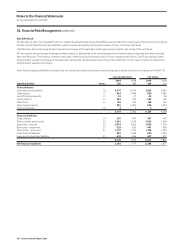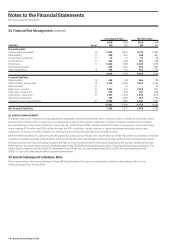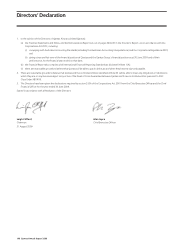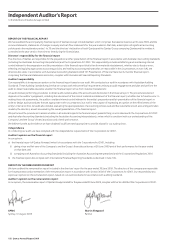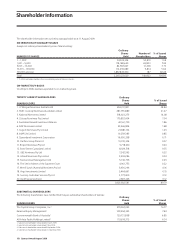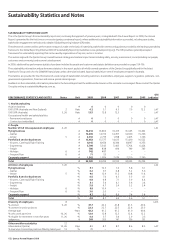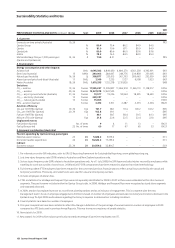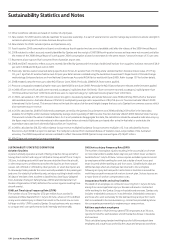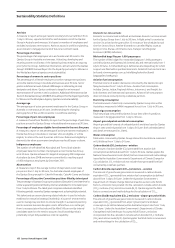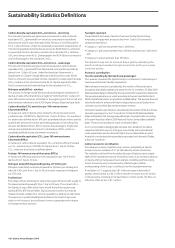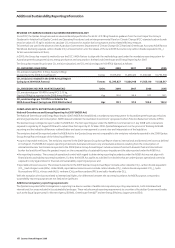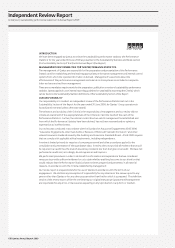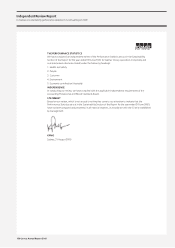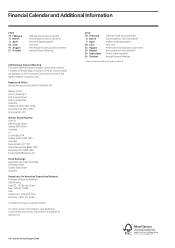Qantas 2009 Annual Report Download - page 159
Download and view the complete annual report
Please find page 159 of the 2009 Qantas annual report below. You can navigate through the pages in the report by either clicking on the pages listed below, or by using the keyword search tool below to find specific information within the annual report.
157 Qantas Annual Report 2009
Additional Sustainability Reporting Information
CO2 EMISSIONS (AVIATION) Units 2008 2007 2006 2005
CO2 emissions (using IPCC 3.15 kg, Gravity 0.78 kg)
(as reported in the 2008 Annual Report) Tonnes 11,915,050 11,499,423 11,206,962 10,793,578
CO2 emissions restated in the 2009 Annual Report
(using June 2009 NGA Factors) Tonnes 12,295,827 11,866,918 11,565,110 11,138,517
CO2 EMISSIONS KGS PER 100 RTKS (QANTAS) Units 2008 2007 2006 2005
CO2 emissions kgs per 100 RTKs (using IPCC 3.15 kg,
Gravity 0.78 kg) (as reported in the 2008 Annual Report) Kgs 95.0 94.4 97.1 99.1
CO2 emissions kgs per 100 RTKs restated in the
2009 Annual Report (using June 2009 NGA Factors) Kgs 98.1 97.4 100.2 102.2
REVISION OF CARBON DIOXIDE (CO2) EMISSIONS METHODOLOGY
Since 2007, the Qantas Group has used an assumed density specification for Jet-A1 of 0.78 kg (based on guidance from the Joint Inspection Group’s
Guidance for Aviation Fuel Quality Control and Operating Procedures) and an Intergovernmental Panel on Climate Change (IPCC) standard carbon dioxide
emission value of 3.15 kg for aviation to calculate CO2 emissions for aviation fuel consumption and its related efficiency measure.
This method was used in the absence of the Australian Government’s Department of Climate Change (DCC) National Greenhouse Accounts (NGA) Factors
Workbook disclosing separate carbon dioxide (CO2) emission factors until the release of the June 2009 Accounts (only carbon dioxide equivalent (CO2-e)
factors were disclosed until then).
In 2009, the Group has revised its method to use the DCC’s NGA Factors to align with the methodology used under the mandatory reporting system for
Australian greenhouse gas emissions, energy production and consumption, the National Greenhouse and Energy Reporting Act 2007.
The Group has restated its prior year CO2 emissions (aviation) and CO2 emissions (kgs per 100 RTKs) (Qantas) as follows:
COMPLIANCE WITH REPORTING REQUIREMENTS
National Greenhouse and Energy Reporting Act 2007 (NGER Act)
The National Greenhouse and Energy Reporting Act 2007 (NGER Act) established a mandatory reporting system for Australian greenhouse gas emissions
and energy production and consumption. NGER data will underpin the Australian Government’s proposed Carbon Pollution Reduction Scheme (CPRS).
The Qantas Group is obliged to report under the NGER Act. The first reporting year under the NGER Act commenced on 1 July 2008 with corporations
required to register by 31 August 2009 and to submit their first report by 31 October 2009. Qantas Management is in the process of finalising its NGER
reporting and the indicative differences outlined below are based on management’s current view and interpretation of the legislation.
The emissions that will be reported under the NGER Act for the Qantas Group are not comparable to the emissions voluntarily reported in the 2009 Qantas
Group Annual Report because of the following differences:
•scopeofreportableemissions.Theemissionsreportedinthe2009QantasGroupAnnualReportrelatetointernationalanddomesticemissionsasdefined
in the Report. The NGER Act requires reporting of domestic Australian emissions only and excludes emissions resulting from the consumption of
international bunker fuel. Emissions reported in the 2009 Qantas Group Annual Report include emissions from both domestic fuel and international
bunker fuel and this will have the greatest impact on the comparability of sustainability reporting data and the data reported under the NGER Act;
•thereportingboundary.TheconceptofoperationalcontrolwithregardtodeterminingreportingboundariesundertheNGERActmaynotalignwith
financial and sustainability reporting boundaries. Further, the NGER Act applies to activities from facilities that are under Qantas’ operational control as
opposed to only legal entities for financial and sustainability reporting purposes; and
•reportableemissionssources.Theemissionsreportedinthe2009QantasGroupAnnualReportincludecarbondioxide(CO2), carbon dioxide equivalent
(CO2-e) and nitrogen oxide (NOx). Under NGER, reportable emissions sources include carbon dioxide (CO2), carbon dioxide equivalent (CO2-e), hydro
fluorocarbons (HFCs), nitrous oxide (N2O), methane (CH4) perflourocarbons (PFCs) and sulfur hexafluoride (SF6).
With the exception of emissions related to international flights, the differences between the reporting boundaries for NGER purposes compared to
sustainability reporting purposes are not likely to be significant.
Additional compulsory reporting requirements
The Qantas Group also fulfils its obligations in reporting to a diverse number of additional compulsory reporting requirements, both state based and
international, for areas included in its sustainability landscape. These include annual reporting requirements to a number of Australian Government bodies
such as the Equal Opportunity for Women Agency (EOWA), Greenhouse FriendlyTM and the Energy Efficiency Opportunities (EEO).


